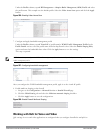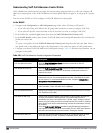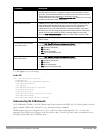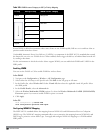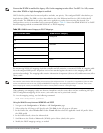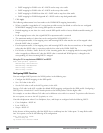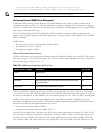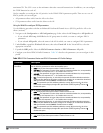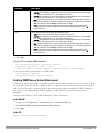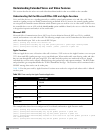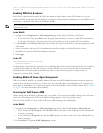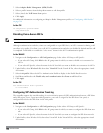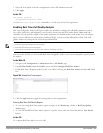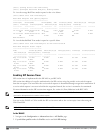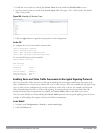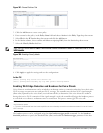
Parameter Description
l ecw-max: The exponential (n) value of the maximum contention window size, as expressed by
2
n
-1. A value of 4 computes to 2
4
-1 = 15. Possible values are 1-15.
l ecw-min: The exponential (n) value of the minimum contention window size, as expressed by
2
n
-1. A value of 4 computes to 2
4
-1 = 15. Possible values are 0-15.
l txop: Transmission opportunity, in units of 32 microseconds. Divide the desired transmission
duration by 32 to determine the value to configure. For example, for a transmission duration of
3008 microseconds, enter 94 (3008/32). Possible values are 0-2047.
l acm: This parameter specifies mandatory admission control. With a value of 1, the client
reserves the access category through traffic specification (TSPEC) signaling. A value of 0
disables this option.
Voice Set the following parameters to define the background queue.
l aifsn: Arbitrary inter-frame space number. Possible values are 1-15.
l ecw-max: The exponential (n) value of the maximum contention window size, as expressed by
2
n
-1. A value of 4 computes to 2
4
-1 = 15. Possible values are 1-15.
l ecw-min: The exponential (n) value of the minimum contention window size, as expressed by
2
n
-1. A value of 4 computes to 2
4
-1 = 15. Possible values are 0-15.
l txop: Transmission opportunity, in units of 32 microseconds. Divide the desired transmission
duration by 32 to determine the value to configure. For example, for a transmission duration of
3008 microseconds, enter 94 (3008/32). Possible values are 0-2047.
l acm: This parameter specifies mandatory admission control. With a value of 1, the client
reserves the access category through traffic specification (TSPEC) signaling. A value of 0
disables this option.
5. Click Apply.
Using the CLI to configure EDCA parameters
wlan edca-parameters-profile {ap|station} <profile>
{background | best-effort | video | voice}
[acm][aifsn <number>] [ecw-max <exponent> [ecw-min <exponent>] [txop <number>]
To associate the EDCA profile instance to a SSID profile:
wlan ssid-profile <profile>
edca-parameters-profile {ap|sta} <profile>
Enabling WMM Queue Content Enforcement
WMM queue content enforcement is a firewall setting that you can enable to ensure that the voice priority is used
for voice traffic. When this feature is enabled, if traffic to or from the user is inconsistent with the associated QoS
policy for voice, the traffic is reclassified to best effort and data path counters incremented. If TSPEC admission
were used to reserve bandwidth, then TSPEC signaling is used to inform the client that the reservation is
terminated.
You can use the WebUI or CLI to enable WMM queue content enforcement.
In the WebUI
1. Navigate to the Configuration > Advanced Services > Stateful Firewall page.
2. Select Enforce WMM Voice Priority Matches Flow Content.
3. Click Apply.
In the CLI
firewall wmm-voip-content-enforcement
DellPowerConnectW-SeriesArubaOS6.2 | User Guide Voiceand Video | 702



